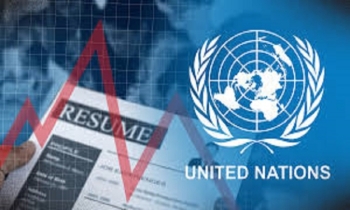Food price inflation remains high around world: WB
BI Report || BusinessInsider

Photo: Collected
The World Bank (WB) in recent data shows that the domestic food price inflation in almost all low-and middle-income countries remains high across the world between October 2022 and February 2023.
According to the food price inflation data, the high inflation in almost all low-and middle-income countries, with inflation levels above 5 percent in 94.1 percent of low-income countries, 86 percent of lower-middle-income countries and 87.0 percent of upper-middle-income countries and many experiencing double-digit inflation.
In addition, around 87.3 percent of high-income countries are experiencing high food price inflation during the October 2022 and February 2023 period.
The countries affected most are in Africa, North America, Latin America, South Asia, Europe and Central Asia, said the WB in its latest report published on March 13.
The agriculture and cereal price indices closed 2 percent and 5 percent lower, respectively, compared to two weeks ago, while the export price index closed at the same level.
Maize, wheat and rice prices all closed lower compared to two weeks ago i.e., their prices were 6, to 7 percent and 2 percent lower respectively.
On a year-on-year basis, maize and wheat prices are 15 percent lower, whereas rice prices are 19 percent higher.
Compared to January 2021, maize and wheat prices are 24 percent and 7 percent higher, respectively, while rice prices are 3 percent lower. (See “pink sheet” data for agricultural commodity and food commodity prices indices, updated monthly.)
The March 2023 edition of the Agricultural Market Information System (AMIS) Market Monitor underscores the uncertainty hanging over agricultural markets as the war in Ukraine continues.
Reduced Ukrainian production suggests that other countries will need to plant additional grains and oilseeds to help rebuild global stocks and ease prices.
Although fortunate weather and a strong producer supply response have kept market prices from returning to early 2022 levels, tight supplies will mean greater price volatility, especially during unpredictable periods such as cropping cycles in the northern hemisphere.
Uncertainty surrounding the renewal of the Black Sea Grain Initiative will also keep markets in turmoil.
Global food prices, despite having fallen from historic peaks, remain high and new export restrictions could send prices soaring again.
One year after Russia’s invasion of Ukraine, many of those export-limiting measures have lapsed, and high prices mostly reflect broad global inflation, but the number of restrictions remaining in place is still troubling, 101 export restrictions—including quotas, licenses, and outright bans—are still being enforced, contrary to World Trade Organization principles that the limits should be temporary.
It has been estimated that those restrictions covered more than 11 percent of global food trade in 2022, with export bans alone responsible for 3.8 percent.
Although countries with a small share of food exports account for most of the remaining restrictions, even those are causing price distortions and should be lifted.
One year after Russia’s invasion of Ukraine, the International Food Policy Research Institute (IFPRI) reviewed experiences of the past year and remaining uncertainties about food security in the future.
The war in Ukraine jeopardized more than one-third of the world wheat trade, 17 percent of the world maize trade, and almost 75 percent of the world sunflower trade, causing prices of wheat futures to jump almost 60 percent within a week of the war’s outbreak; corn and soybean prices were up more than 15 percent.
Although the world faced the possibility of another food price crisis, the worst-case scenarios for agricultural trade and food security were largely averted, with prices falling back to pre-war levels by August 2022 because of efforts such as the partial re-opening of ports through the Black Sea Grain Initiative and an increase in global humanitarian efforts to mitigate the impacts of the war.
As Russia’s invasion of Ukraine continues, uncertainty remains in agricultural markets. With ending stocks for 2022/23 the lowest since 2007/08 for wheat and 2012/13 for maize and soybeans, global supplies are tight, which will increase price volatility during periods of uncertainty, such as growing seasons in the northern hemisphere.
Such instability may lead to future market disruptions, which requires close monitoring for the upcoming year.
According to the Global Report on Food Crisis 2022 Mid-year Update, up to 205 million people are expected to face acute food insecurity and to be in need of urgent assistance in 45 countries.
World Bank Action
As part of a comprehensive, global response to the food security crisis, in April 2022 the World Bank announced that it is making up to $30 billion available over a period of 15 months, including $12 billion in new projects.
The financing is to scale up short- and long-term responses along four themes to boost food and nutrition security, reduce risks, and strengthen food systems: (i) support producers and consumers, (ii) facilitate increased trade in food and trade inputs, (iii) support vulnerable households, and (iv) invest in sustainable food and nutrition security.
Between April and December 2022, the Bank’s food and nutrition security commitments in new lending have passed the $12 billion mark – with almost half for Africa, which is one of the hardest hit regions by the food crisis. Some examples include:
1. $50 million grant of additional financing for Tajikistan to mitigate food and nutrition insecurity impacts on households and enhance the overall resilience of the agriculture sector.
2. A $125 million project in Jordan aims to strengthen the development of the agriculture sector by enhancing its climate resilience, increasing competitiveness and inclusion, and ensuring medium- to long-term food security.
3. A $300 million project in Bolivia that will contribute to increasing food security, market access and the adoption of climate-smart agricultural practices.
4. A $315 million loan to support Chad, Ghana and Sierra Leone to increase their preparedness against food insecurity and to improve the resilience of their food systems.
5. A $500 million Emergency Food Security and Resilience Support Project to bolster Egypt's efforts to ensure that poor and vulnerable households have uninterrupted access to bread, help strengthen the country's resilience to food crises, and support to reforms that will help improve nutritional outcomes.
6. A $130 million loan for Tunisia, seeking to lessen the impact of the Ukraine war by financing vital soft wheat imports and providing emergency support to cover barley imports for dairy production and seeds for smallholder farmers for the upcoming planting season.
7. The $2.3 billion Food Systems Resilience Program for Eastern and Southern Africa, helps countries in Eastern and Southern Africa increase the resilience of the region’s food systems and ability to tackle growing food insecurity.
The program will enhance inter-agency food crisis response also boost medium- and long-term efforts for resilient agricultural production, sustainable development of natural resources, expanded market access, and a greater focus on food systems resilience in policymaking.
In May, the World Bank Group and the G7 Presidency co-convened the Global Alliance for Food Security, which aims to catalyze an immediate and concerted response to the unfolding global hunger crisis.
The Alliance has developed the publicly accessible Global Food and Nutrition Security Dashboard, which provides timely information for global and local decision-makers to help improve coordination of the policy and financial response to the food crisis.
The heads of the FAO, IMF, World Bank Group, WFP, and WTO released a Third Joint Statement on February 8, 2023. The statement calls to prevent a worsening of the food and nutrition security crisis, further urgent actions are required to (i) rescue hunger hotspots, (ii) facilitate trade, improve the functioning of markets, and enhance the role of the private sector, and (iii) reform and repurpose harmful subsidies with careful targeting and efficiency. Countries should balance short-term urgent interventions with longer-term resilience efforts as they respond to the crisis.
























